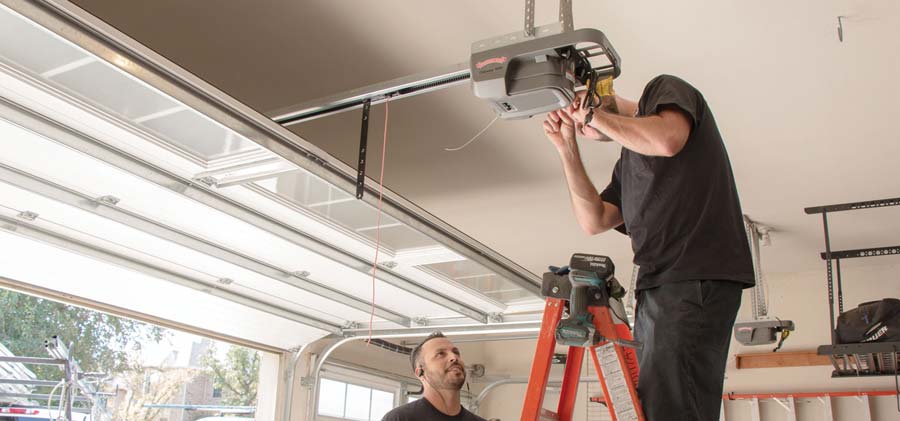When your garage door goes off track, it can lead to serious safety and security risks. Knowing how to handle garage door off track situations early can save you time and money. It can also help avoid more significant damage later.
Let us understand what causes garage door off track issues and when to call professionals for garage door realignment.

What Does It Mean When a Garage Door Is Off Track?
A garage door operates using metal tracks on both sides. The rollers guide the door up and down along these tracks. If the rollers come out of these tracks, the door can’t move smoothly anymore. An off-track door may tilt, jam, or become stuck completely.
Some signs that your garage door is off track include:
- The door appears crooked or slanted.
- You hear loud grinding or scraping sounds from garage door.
- There are visible gaps between the rollers and the tracks.
- The door doesn’t move at all or moves only partially.
If you ignore these problems, it can put a strain on other components, like the opener or springs. It may lead to expensive repairs down the line.
Common Causes of a Garage Door Going Off Track
Understanding what causes garage door off track issues is crucial. Here are some common reasons for garage door derailment
- Broken Lift Cables: Lift cables help move the door up and down. When one cable breaks, it disrupts the balance. This tension imbalance can push the door off track. It can lead to more damage and operational issues.
- Misaligned Tracks: If the tracks become loose or bent, the rollers will not align correctly. This misalignment causes the door to derail. Regularly check the tracks to make sure they stay secure. This practice can prevent serious problems from developing.
- Obstructions in the Track: Debris can gather in the tracks, blocking the rollers. Things like leaves, sticks, or tools can become obstacles. When rollers can’t move smoothly due to obstructions, they may jump the track. Always keep your tracks clear to avoid issues.
- Roller Problems: Over time, rollers can become worn-out or broken. Cracked or rusted rollers do not roll smoothly. This situation can lead them to slip out of the track. Inspect and replace faulty rollers regularly to maintain the door’s operation.
- Impact Damage: Accidents may happen, such as backing into the garage door. Even minor impacts can shift or warp the tracks. If this occurs, inspect the door for any damage and make repairs as needed.
- Pro Tip: Check your garage door tracks at least once a month. Early detection of alignment issues can help avoid major problems.
How To Fix the Issue of a Garage Door Going Off Track
Before starting to fix an off-track garage door, professionals understand that these systems have high tension. Prioritizing safety is the key. Let us know the required tools before understanding how to fix garage door off track issues.
Required Tools
To fix a garage door off track, the following tools are required:
- Ladder: To reach the top of the door.
- Locking Pliers: To secure the door while working.
- Wrench: For loosening and tightening bolts.
- Rubber Mallet: To realign the tracks.
Step 1: Disconnect the Garage Door Opener
The procedure starts by pulling the emergency release cord, usually a red handle. This step disconnects the door from the opener, allowing for manual movement of the door without activating the motor.
Step 2: Open the Door Manually
Experts lift the garage door until the rollers are out of the track. They use locking pliers to clamp just below the bottom roller on each side, keeping the door stable and preventing movement during the repair.
Step 3: Realign the Track
If the tracks are loose or bent, professionals will loosen the bolts holding the track using a wrench. They gently tap the track with a rubber mallet to realign it. Once it is straightened, they tighten the bolts to secure the track.
Step 4: Reset or Replace Damaged Rollers
Professionals carefully examine each roller for damage. If they find any cracked or misshapen rollers, they remove the hinge and slide out the old roller, replacing it with a new one. This process is straightforward and helps restore the door’s function.
Step 5: Reconnect the Opener and Test
After removing the locking pliers, the garage door is reconnected to the opener. Then, a test is performed by opening and closing the door several times to ensure smooth operation. If any unusual noises are still noticed, that may indicate misaligned tracks or roller issues.

Conclusion:
Addressing a garage door that is off track can be handled effectively by professionals who know the correct procedures. By understanding common issues and following these steps, they can resolve the problem safely and efficiently.
FAQs
Common signs include the door appearing crooked or slanted when opening or closing. You might hear loud grinding or scraping noises, or notice visible gaps between the rollers and tracks. If the door won’t move at all or only partially opens, it is likely off track.
You should always call a professional for fixing garage door off-track issues. Professionals know exactly what is causing garage door going off-track. They have the skills and expertise to fix such issues without facing accidents or injuries.
Several factors can contribute to a garage door going off track, including broken lift cables, misaligned tracks, and obstructions in the track, roller problems, and impact damage. Addressing these issues early can help prevent further damage and ensure the safe operation of your garage door.


